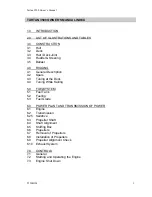
3-3
350 Express Series
Controls and Indicators
DASH PANEL COMPONENTS
(See Dash Panel Layout for component locations.)
1 - Engine Control Panel
IGNITION/START/STOP
These switches start and stop the engines. The engine control
switches on the AC/DC panel must be on and the LEDs lit to energize
the ignition switches. Stop the engines and turn the engine control
switches on the AC/DC panel off when the boat is not in use or left
unattended.
BLOWERS - BILGE
Push to turn on; push again to turn off. The LED will indicate if the
blowers are on.
PARALLEL - BATTERY
This is a momentary function that controls the battery parallel
solenoid. When this button is pressed, the battery parallel solenoid is
energized, connecting the two cranking batteries in parallel. When it is
released, the solenoid is de-energized. This function should be used
only when one of the cranking batteries is not charged sufficiently to
start the corresponding engine. The LED will turn on when the button
is pressed.
2 - Starboard Engine Gauges
The descriptions will cover both the starboard and port engine
gauges (item 13).
ENGINE TACHOMETERS
These gauges register engine crankshaft RPMs. Propeller shaft
RPMs are approximately one-half of engine crankshaft RPMs. Refer
to your engine owner’s manual for the appropriate engine speed.
VOLTMETERS - ENGINE
Normal operating voltage, when engines are above 1000 RPMs, is
between 12.0 and 15.5 volts. Higher or lower readings would indicate
that there is a problem. Refer to your engine owner’s manual for
details, and see your Cruisers Yachts Dealer for more information.
TRIM GAUGES
These gauges indicate the angle position of the engines’ outdrive
relative to the position of the bow, up or down when boat is on plane.
Use this gauge in combination with the trim switches located in the
throttle control.
OIL PRESSURE GAUGES
The port gauge is an oil pressure gauge for the port engine, and the
starboard gauge is an oil pressure gauge for the starboard engine.
These gauges indicate the pressure of the lubricating oil inside the
engine. Make a note of the oil pressure reading when the yacht is
new. This can be considered your engine’s normal oil pressure.
Fluctuations will occur in the pressure under different operating
speeds, but major deviations may signal problems. If pressure drops
radically or is not registering, turn the engines off and see your
Cruisers Yachts Dealer.
TEMPERATURE GAUGES - ENGINE
These gauges indicate cooling water temperature inside the engines.
Normally the gauge will register between 170°F (77°C) and 195°F
(91°C). Consult your engine owner’s manual if the gauge registers
outside of this range.
Downloaded
from
CruisersOwnersForum
http://www.CruisersOwnersForum.com
















































